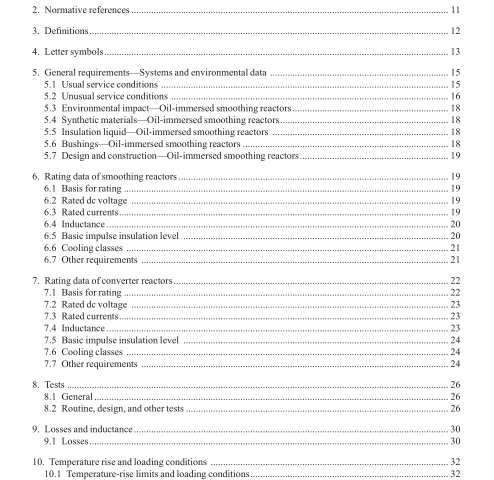IEEE 1277-2020 pdf download.IEEE Standard General Requirements and Test Code for Dry-Type and Oil-Immersed Smoothing Reactors and for Dry-Type Converter Reactors for DC Power Transmission
4. Letter symbols
A altitude
A o standard reference altitude of 1000 m
5. General requirements—Systems and environmental data
5.1 Usual service conditions
5.1.1 General Smoothing reactors and converter reactors conforming to this standard shall be suitable for operation at currents as per 6.3.2 and as per 7.3.3 under the usual service conditions defined in 5.1.2 to 5.1.4.
5.1.2 Temperature When air is the cooling medium, the temperature of the cooling air (see “ambient temperature” in Clause 3) shall not exceed 40 °C, and the average temperature of the cooling air for any 24 h period shall not exceed 30 °C. The usual minimum ambient temperature is considered to be –40 °C. Converter reactors are also often installed indoors under a controlled environment. Such service conditions need to be specifed in detail, particularly, the long-term ambient temperature profle may differ signifcantly due the control of heat exchange in the converter reactor room.
Also, the maximum ambient temperature may exceed 40 °C. In addition to the temperature profle, the associated minimum humidity shall be specifed. Such cases should be described as unusual service conditions, and full details shall be provided in the reactor specifcation. The case of oil-immersed smoothing reactors operating with bushings projecting into a valve hall, where ambient temperatures exceed 40 °C, does not constitute an unusual operating condition for the smoothing reactor. The valve hall maximum temperature and minimum humidity shall only be specifed as an unusual service condition for the internal and external insulation of the bushing.
5.1.3 Altitude The altitude shall not exceed 1000 m.
5.1.4 Installation location Outdoor installation is the usual operating environment. However, converter reactors are frequently installed indoors.
5.2 Unusual service conditions Conditions other than those described in 5.1 are considered unusual service, and when prevalent these conditions should be brought to the attention of those responsible for the design and application of the apparatus.
5.2.1 Unusual ambient temperature conditions
The temperature-rise limits of reactors should be adjusted if the cooling air ambient temperature exceeds the limits described in 5.1.2. If the cooling air ambient temperature at site exceeds either of the limits, then the specified temperature-rise limits for the reactor shall be reduced by the same amount as the excess. The adjusted temperature-rise limits shall be rounded to the nearest whole number of degrees Celsius. Minimum ambient temperatures below –40 °C should be specifed as they may have an impact on the reactor. If a particular current rating versus ambient temperature performance is required without additional loss of life, this shall be clearly defned in the specifcation.
For indoor reactors, the ambient temperature inside the reactor hall usually exceeds the limits described in
5.1.2 Higher ambient air temperature results in lower air density that contributes to reduce the dielectric withstand of air insulation. Thus, the specifed dielectric withstand voltages shall be associated with the reactor hall ambient air conditions (e.g., maximum air temperature and associated minimum air humidity). If dielectric tests are performed at usual laboratory ambient air conditions, correction factors shall be applied to test voltages in order to take into account the most stringent ambient conditions prevailing in the reactor hall. Correction factors shall be calculated according to the methodology defned in IEEE Std 4™.
NOTE—Smoothing and converter reactors may be uniquely (custom) specifed and designed for a specifc location and set of operating conditions and, therefore, loading versus ambient temperature condition may be the norm. Establishing a current rating versus ambient temperature, etc., involves a number of considerations such as the thermal capability of the insulation system versus the winding operating temperature under rated conditions. This may be affected by a signifcant loss evaluation or other aspects of the specifcation, which reduces the temperature rise of the winding below the insulation system thermal capabilities.IEEE 1277 pdf dwonload.IEEE 1277-2020 pdf download
IEEE 1277-2020 pdf download

Leave a Reply